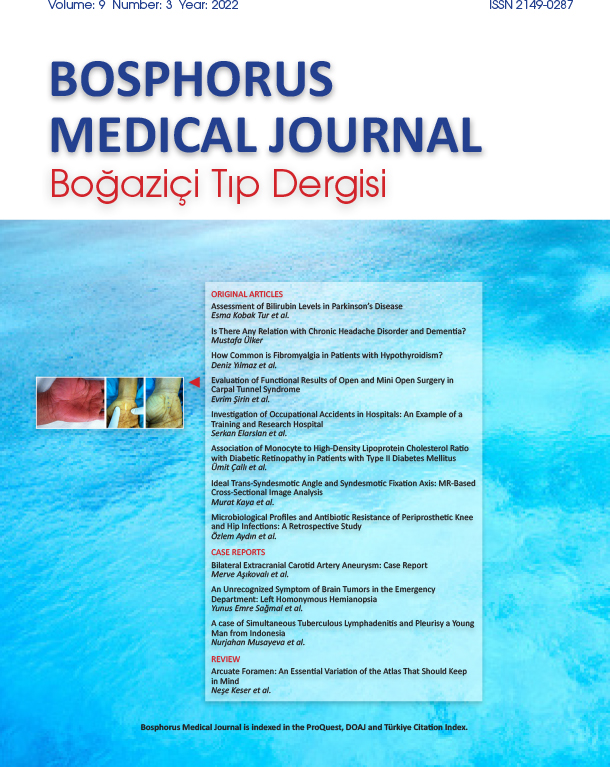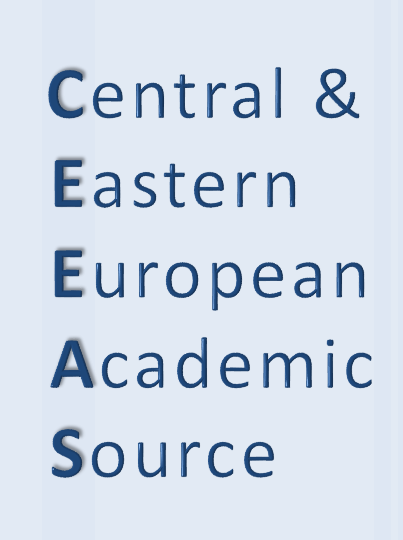Volume: 5 Issue: 2 - 2018
| ORIGINAL RESEARCH | |
| 1. | The Evaluation of the emerging changes in Nocturia According to its Subgroups in Patients Who Underwent Prostatectomy due to Benign Prostatic Hyperplasia Abdullah Çırakoğlu, Ferhat Ateş, Hasan Soydan, İlker Akyol, Temuçin Şenkul, Kadir Baykal doi: 10.15659/bogazicitip.18.10.899 Pages 47 - 50 Aim: The frequency of lower urinary tract symptoms (LUTS) increase with aging in males. Benign prostatic hyperplasia (BPH) is one of the most common causes of nocturia in men. Nocturia, which is one of the main symptoms of the LUTS, impairs the quality of life significantly. However, it is not yet known if an improvement in nocturia occurs in patients after undergoing successful surgical treatment for BPH. We aimed to determine the changes that emerge in the number and the types of nocturia according to its subgroups, and the effects this has on the quality of life in men with BPH after surgical treatment. Materials and Methods: Patients with BPH who underwent prosta- tectomy from April 2006 to March 2009 were included in our study. In accordance with the definition made by the International Conti- nence Society (ICS), nocturia was recognized as waking up at night for voiding. We divided our patients into four subgroups of nocturia as follows; polyuria, nocturnal polyuria, reduced bladder capacity at night, and overactive bladder type. The patients were told to keep a diary of voiding for three days three months before and three months after the surgery. Their uroflowmetry and postvoiding urine volumes were recorded. They filled the IPSS and the nocturia specific quality of life (QOL) forms. Prostate volumes were measured with abdominal ultrasonography. The patients other chronic diseases and the recent medical treatments they received were recorded. Results: We found that nocturia decreased in half of the whole group of patients after undergoing prostatectomy (p<0.001). When evaluated according to the subgroups of nocturia, the greatest improvement occurred in the AAM group. In addition to this, we found that changes in subtypes of nocturia can occur postoperatively in some patients. Conclusion: The type of nocturia in men should be evaluated in detail before prostatectomy, as this may be of help in predicting possible improvements in nocturia after surgery. |
| 2. | The Analysis of Adult Patients Admitted to Third Level Emergency Department by 112 Ambulance Atilla Silibolatlaz, Müge Gülen, Akkan Avci, Salim Satar doi: 10.15659/bogazicitip.18.10.796 Pages 51 - 57 INTRODUCTION: In this study, we aimed to analyze the demographic characteristics of patients who were brought to our emergency department by ambulance, whether or not adequate medical treatment had been initiated during transportation, and the necessity of moving to a 3rd stage emergency department which also serves as a trauma center according to the outcomes of said emergency service. METHODS: In this study, the analysis of adult patients who were brought to the Republic of Turkey Ministry of Health Adana Numune Training and Research Hospital by ambulance between May 1 and October 31 in 2016 was prospectively performed. Patients were recorded according to their gender, their date of admission to the emergency service, the time it took for them to arrive the hospital, the reason why they were initially brought in and where exactly they were taken. The treatment and interventions of the ambulance team were evaluated. The preliminary diagnosis of the ambulance team and the diagnosis of the emergency services were classified, and the outcomes of the patients were evaluated. RESULTS: 4976 cases were included in the study. 51.6% of the cases were male and 48.4% were female. According to the date and time the patients were brought in, the greatest number of applications was in May with 21.2%, on Fridays with 15.7%, and between 16: 00 and 24: 00 with 45.5%. It was determined that only 21.3 % of the patients were taken with consent. It was found that most of the patients were brought in the emergency services from trauma. According to the description of emergencies, as defined by the World Health Organization (WHO), it was determined that 53.7% of the patients did not have an indication necessitating ambulance transportation. It was found that 78% of the transferred patients were discharged immediately, 21% were admitted and 1% were exitus. DISCUSSION AND CONCLUSION: The out of hospital medical personnel and the 112 command and control centers are inadequate in terms of medical intervention and appropriate patient transfer respectively. In order to correct this situation, it is necessary to provide continuous in-service training for pre-hospital healthcare personnel. Adherence to the guidelines of referral can significantly reduce the unnecessary referrals. |
| 3. | Epidemiological Evaluation of Pediatric Patients Admitted to the Emergency Ophthalmology Clinic Ayşin Tuba Kaplan, Nilüfer Zorlutuna Kaymak, Nesrin Tutaş Günaydın, Ayşe Yeşim Oral, Şaban Şimşek doi: 10.15659/bogazicitip.18.10.901 Pages 58 - 61 INTRODUCTION: In this study, our purpose was to evaluate the epidemiological features of pediatric patients with ocular complaints who were admitted to the emergency department of our ophthalmology clinic. METHODS: The records of pediatric patients under 18 years of age who were admitted to the Health Sciences University Dr. Lütfi Kırdar Kartal Training and Research Hospital emergency department with ocular complaints between June 2017 and January 2018, were retrospectively analyzed. We evaluated the patients demographic characteristics such as age and gender, as well as their affected eye, ocular pathologies, causes of trauma, causative materials, and treatment methods. Data were statistically evaluated with SPSS version 20.0. RESULTS: In our study, 1296 patients between 0-18 years of age were retrospectively analyzed. Patients with missing records have been excluded from the study. Of the patients who were included, 770 (59.4%) were male and 526 (40.6%) were female. Among the age range of 0-18 years, the mean was 8.75 years of age, and the majority of cases were in the 0-2 age group. In the greatest number of incidents, the left eye was solely affected with 42.8%, it was the right eye only in 39.6% of the cases, and both eyes were affected in 17.6% of the cases. The most common diagnosis was conjunctivitis (39.7%) and the se- cond most was ocular trauma with a rate of 24.5%. Of the patients, 97.3% were treated with medical therapy, and 2.7% needed surgical therapy. DISCUSSION AND CONCLUSION: Our study demonstrates that pediatric ophthalmic emer- gency diagnoses are as wide in variety as those of adults. We also think that taking more precautions and providing better education may prove itself crucial in preventing the greater number of ophthal- mic injuries in the pediatric group, which has a high frequency of trauma. |
| CASE REPORT | |
| 4. | Postoperative Bronchial Barium Aspiration in Intensive Care Unit Serkan Uçkun, Tamer Kuzucuoğlu, Feriha Temizel doi: 10.15659/bogazicitip.18.10.928 Pages 62 - 64 Barium sulfate (BS) is an inert substance widely used in the detection of swallowing abnormalities and during bronchial aspirations, due to having no significant side effects and a low osmolality. BS is considered to be safe, as it has no mucosal absorption, and it is widely used in medicine. The accidental aspiration of BS has been recognized frequently, and the course after this event mostly remains silent. Herein, we think that, during patient care in intensive care units (ICU), the time of feeding, the position of the patient and a close follow-up of the clinical course should decrease the rate of possible complications. In this case report, an incident of BS aspiration during post-operative feeding in the ICU after undergoing total thyroidectomy surgery was described in a 75-year-old patient with the anesthesia risk group American Society of Anesthesiologists score of 3, and a discussion was made in regard to data obtained from the literature. |
| 5. | A Case of Syringomyelia with Pure Motor Symptoms Eren Gözke, Pelin Doğan Ak, Sıdıka Sinem Taşdemir, Mustafa Eser, Zehra Aktan doi: 10.15659/bogazicitip.18.10.978 Pages 65 - 66 A syrinx is a fluid-filled neuroglial cavity within the spinal cord which causes sensory and motor symptoms according to its location. It is rare for a clinical presentation to develop with pure motor symptoms, with no sensory symptoms. Herein, we report a case of a 38-year-old woman who had a syrinx extending along the thoracic cord from the lower cervical region, who had motor symptoms and no sensory complaints. |
| 6. | An Uncommon Cause of Syncope: Acidosis due to Ruptured Body Packing A Case Report and Review of the Literature Mehmet Koçak, Ebru Ünal Akoğlu doi: 10.15659/bogazicitip.18.10.983 Pages 67 - 69 Drug trafficking by the way of body packing is on the rise in Turkey, as well as all over the world. Turkey acts as both an end destination and a country of transit for drug smugglers. Drugs can be carried in capsules, condoms, balloons and small packets, usually divided into 50-100 packs of 8-10 grams each. If these packages are to be ruptured and absorbed in the gastrointestinal tract, it might result in a quick death for the carrier, the risk of which is usually ignored by many for monetary reasons. Herein, along with a review of the literature, we present a case of body packing in which the carrier suffered syncope and head trauma at the Istanbul International Airport during transfer, and needed surgery to remove ruptured drug capsules. |
| 7. | Bilateral Elastofibroma Dorsi Mimicking Spondylitis Exacerbation: Case Report Betül Sevinç, Feyza Ünlü Özkan, İlknur Aktaş, Özge Gülsüm İlleez, Işıl Üstün, Esin Derin Çiçek doi: 10.15659/bogazicitip.18.10.979 Pages 70 - 71 Elastofibroma dorsi is an uncommon, benign, soft tissue tumor which develops in the space between the periscapular region and the posterior thoracic wall. It is usually found in the 40- 60 age range, and mostly in women. Although it is usually unilateral in its manifestation, it may also be bilateral in some cases. Symptomatic patients typically complain from a shoulder pain which is aggravated by movement, or from chronic dorsal pain. Magnetic resonance imaging is one of the most useful diagnostic methods. In the surgical treatment of symptomatic cases, marginal resection is used. Elastofibroma dorsi should be taken into consideration in the differential diagnosis of cases with chronic shoulder and dorsal pain. |
| REVIEW | |
| 8. | Anterior Cruciate Ligament Injuries and Their Treatment Ömer Can Özkan, Burak Yağmur Öztürk doi: 10.15659/bogazicitip.18.10.987 Pages 72 - 75 The anterior cruciate ligament is a structure with important functions in knee stability. The injuries of the anterior cruciate ligament cause a sense of instability and pain in the knee, and the aim of a surgical intervention is to treat these symptoms and recover the functionality of the knee joint. In this review, the anatomy and the function of the anterior cruciate ligament are summarized, and contemporary treatment principles and options considered. |




















